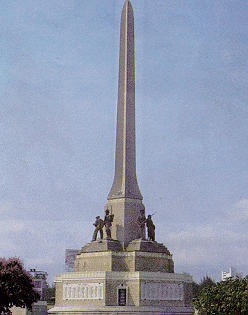Thailand and the Indo-Chinese Nationalist Movements
In conducting a policy designed to keep intact the ceded territories in Indo-China, Thai decision-makers were well aware of their military and economic weakness in comparison with the French and also of the rise of militant nationalism in Indo-China. The Thais therefore sought to draw the Indo-Chinese independence movements into
Thailand’s scheme of things as a source of countervailing power. These movements were the Lao Issara (Free Lao), Khmer Issarak (Free Cambodia) and Viet Minh(League for the Independence of Vietnam).
The Free Lao Movement
Prince Phetsarath(1890-1959)
Before the outbreak of the Franco-Thai War,
a Laotian man named Thao Oun Sananikone swam across the
Mekong River and worked with the Thais in their propaganda campaigns against the French. After the Pacific War Prince Phetsarath, Viceroy of the
Kingdom of Luang Prabang, is generally considered to be the father of the Lao nationalist movement. In October 1945, the Prince declared
Laos independence of
France and organized a “Lao Issara (Free Lao) Provisional Government” in
Vientiane with Phya Khammao as Prime Minister. The Prince’s declaration of independence was welcomed by the Thai rulers in
Bangkok for they wanted to use the Free Laotians as a counter to the King of Luang Prabang who had refused to recognize the new state of
Laos. He declared his kingdom free and expressed a desire for a
Lao State which would include the territory ceded in 1941, as well as the
northern provinces of Chiengmai and Chiengrai, and the northeastern provinces of
Thailand. The Thai rulers believed that the King’s aspiration would be supported by
France.
The Free Cambodian Movement
Khmer Issarak's Red Flag
Cordial Thai-Free Cambodian relations had existed before the outbreak of the Pacific War.
Thailand under Prime Minister Phibunsonggram had already exploited the Cambodian Independence in the interests of a “ Greater Thai Movement.” In 1940, just before the outbreak of the short-lived Franco-Thai war, Pock Khun(Phra Phiset), a retired Cambodian official, came to
Bangkok and founded a “Kher Issarak(Free Cambodian League)” for the purpose of regaining Cambodian independence. Members of the League were recruited among the Cambodian minority in
Thailand including those who had newly escaped from
Cambodia before the outbreak of the Franco-Thai War. The military wing of the Khmer Issarak were trained and organized, along with Vietnamese and Laotians, into an alien battalion affiliated to one of the Thai armies which was sent to occupy Cambodian territories during the Franco-Thai War.
After the Pacific War, despite their memories of bitter pre-colonial relations with
Thailand, the Cambodian nationalists turned to the Thai leaders for assistance.
Thailand’s reluctant return of the Cambodian provinces to the French in November 1946 did not discourage Thai leaders from granting assistance to the Khmer Issaraks. Realizing that the presence in
Thailand of the Issaraks was valuable in view of
Thailand’s non-recognition of the recommendations of the Franco-Thai mixed conciliation commission on June 27, 1947, the Thai leaders accordingly invited the Free Cambodian Provisional Government to
Bangkok and allowed it to set up a committee to co-ordinate its activities there.
The Issarak Movement was replaced by new leaders headed by Houl Vongse-arnuphab as Prime Minister and Ta Ta Rajatipvongse as Deputy Prime Minister. In September 1947, Houl’s group was recognized by
Thailand as the “Free Cambodian Government.” The Issaraks were able then to buy arms, raised money, and even publish a newspaper in
Bangkok.
The Viet Minh League
Viet Minh
Anti-French feeling and the resolved problem of the disputed territories with the French were the main reasons for
Thailand’s alliance with the Vietnamese, its bitter enemy in the pre-colonial era. Thai decision-makes actively encouraged dissident Vietnamese elements in
Thailand, and hoped for a Viet Minh victory in Indo-China, since they considered that this would make the disputed fall into their lap. Both Thais and Vietnamese tried to forget the past and started a new era of friendship with the common objective of destroying French domination in Indo-China. The Thais allowed the Vietnamese to use Thai territory as abase for their political and military activities against the French.
Among the Indo-Chinese nationalists, the Vietnamese movement was best organized. In
Bangkok, the Viet Minh agents had a variety of political organizations. Their
Bangkok headquarters was at Soy Lang-Xuan, one of the centers of the old Vietnamese community, with Dr Nguyen Duc Qui and Le Van Nham as President and Vice President respectively
Generally speaking, Thai civilians leaders of the period were willing to afford sanctuary and offer assistance to the various Indo-Chinese resistance groups even though it was felt that some of them adhered to the doctrine of Communism. Such willingness to offer support was due, on the one hand, to traditional Thai antagonism towards
France, which was regarded as a dangerous and threatening power, especially since it controlled Indo-China, and on the other hand, to the Thai strategic need for countervailing power against
France. As a consequence of their support for the resistance groups Thai strategic interests were furthered in challenging the “ right to rule” of the French in Indo-China.



















